
Everything you need to know about the smart lighting system
Estimated reading time: 1 minute
Despite the competition heating up in recent years, Philips Hue still offers the best smart lighting that you can buy, and the good news is that it’s getting cheaper and easier to trick out your home with the smart light.
Long before the likes of Nanoleaf, Govee, Lifx and Ikea Trådfri arrived on the scene, Signify (previously Philips Lighting) was offering up an array of connected lightbulbs that could be controlled from an app on your smartphone.
And its range has grown since they were first launched in 2012: Philips Hue Bluetooth bulbs have joined the existing Zigbee-powered Philips Hue, which require you to set up an external bridge. And there are even Hue filament bulbs too.
However, a happy house of Philips Hue bulbs isn’t necessarily the easiest thing to achieve. It can be as simple as screwing in a lightbulb to get started, but there is now a such a huge range of Philips Hue bulbs and accessories to choose from, and there’s getting Google Assistant, HomeKit, SmartThings or Alexa and Philips Hue working together.
And we’ve not even mentioned what Matter means for Philips Hue yet.
Luckily, you don’t have to do the difficult Philips Hue research, as we’ve done it for you. Read on for our complete guide to the ultimate Philips Hue setup.
Update: We originally published this guide a fewyears back but we keep it constantly updated with the latest info on all things Hue. The latest update, in June 2024, includes the details on the latest new Hue kit and some new features arriving in the coming months.
Jump to the Hue info you need
How to set up Philips Hue
The traditional Philips Hue setup (as with most other smart lighting systems) uses Wi-Fi and Zigbee wireless signals to connect however many smart lighting devices you want (well, up to 50) within your own system, which you control using an app, or a physical remote.
Once installed (into the regular bulb sockets in your home, or just simply plugged in) you can control brightness, colors, schedules, and integrations with other smart home tech.
In fact, thanks to the likes of Amazon Alexa and Google Assistant, you may find you hardly use the app at all – and instead your home’s lighting will be controlled just with your voice, but we’ll come on to that more in the next section.
The other good news is that you no longer need to have a Hue Bridge or third-party Zigbee hub like the Amazon Echo to run your Hue smart lights. Back in 2021 Signify announced that all new lights going forward will come with the option of Bluetooth support; and we’ve seen the likes of the Lightstrip Plus, Perifo and Bloom arrive with BT on board.
If you choose to rely on Bluetooth you’ll do all the controlling directly from your phone, but you’ll be more limited in what you can do (you can’t control them when you’re outside of that Bluetooth range, for example). Check out our Hue Bluetooth review to learn more.
It’s also important to know that the version of the Hue Bridge that is on sale now, the square one, is the 2nd-generation Bridge. The original Bridge, a round version, saw official support and access to the system’s online services terminated in April 2020.
It’s widely rumored that a new 3rd-gen Hue Bridge will arrive soon… but those rumors have been dragging on for years now.
How to set up a Philips Hue Bridge
1. Plug the Hue Bridge into a power socket and hook it up to your router via ethernet cable.
2. Proceed once the four lights on the Bridge light up.
3. Go to Settings > my Hue System > + > in the Philips Hue app.
4. Follow the setup instructions.
How to set up a Philips Hue bulb
1. First, make sure the Philips Hue Bridge is all set up.
2. Go to Settings > Lights > +
3. Hit Search or manually add the serial number listed on the bulb.
4. Follow the setup instructions, from which point you can name your light and put it into Rooms.
Set up Philips Hue without a bridge
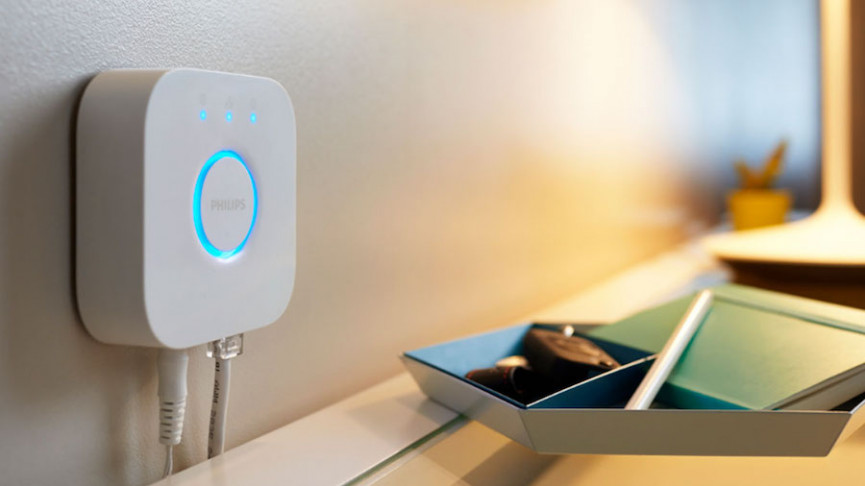
A Philips Hue system generally consists of the Hue Bridge and at least one Hue bulb.
Technically, you don’t actually need a Philips Hue Bridge – you can just use a Hue Dimmer switch or connect using Bluetooth on the newer bulbs – but you’ll be limited to just a simple dimming light situation, for up to 10 bulbs, and that’s hardly embracing the smart home revolution, is it?
If you’ve got an Echo Hub, Echo 4th-gen or one of the newer Echo Show devices, which all act as Zigbee hubs, you also won’t need the Hue bridge to use your bulbs.
However – there’s a small disclaimer here. While these Echo devices do indeed offer more than the basic Dimmer switch control, it’s still not the full Hue bells and whistles. You’ll need a Bridge “to unlock the full Philips Hue experience” – Signify’s words, not ours… but it’s true nonetheless.
Without a Bridge, you’ll be missing out on key features such as lights coming on or off automatically when you enter or leave your home, smart switches and sensor controls, wake up and sleep routines, custom scenes, syncing your lights with music, video and gaming, and access to third-party apps.
Head over to our full guide on this for more in-depth instructions on the different routes you can take, including how to replace the hub with an Ikea gateway.
Philips Hue: Starter Kits
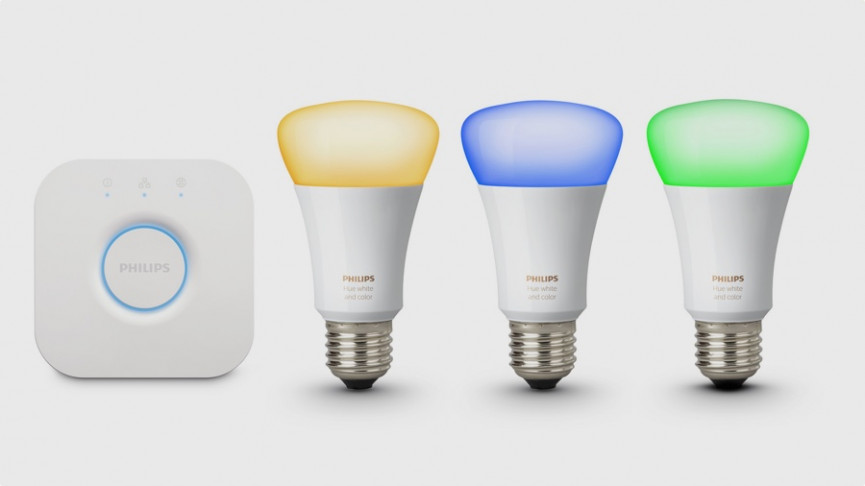
Starter Kits offer a mix of the Bridge and different types of bulbs and there’s a range of options to choose from. Prices start from $69.99 / £69.99 for a kit that comes boxed with the Bridge and two warm-white E26 lightbulbs.
There are also plenty of other bundles available, with GU10 bulbs on offer, more bulbs, Hue buttons and more.
At the top end of the spectrum (spectrum, get it?) you’ll get a Bridge and four multi-colored lights for $199.99, or if you’re in the UK, you can get a pack of three bulbs and a Hue Dummer switch for £169.99.
You can, of course, buy a Bridge on its own for $59 / £49 and then add bulbs to it as you please. Even non-Hue, cheaper, ones; but we’ll get to that in a bit.
Philips Hue: What to buy and where to buy them
There is an absolute plethora of Philips Hue kit currently on sale – more than 100 different packs and devices at the last count.
In both the US and UK, Signify has a dedicated Hue Store where you can buy the latest lights and accessories, while the brand also has a storefront on Amazon as well – and there are often discounts on there.
Here’s a rundown of what to look out when shopping for the best Hue lights and devices…
Philips Hue lightbulbs
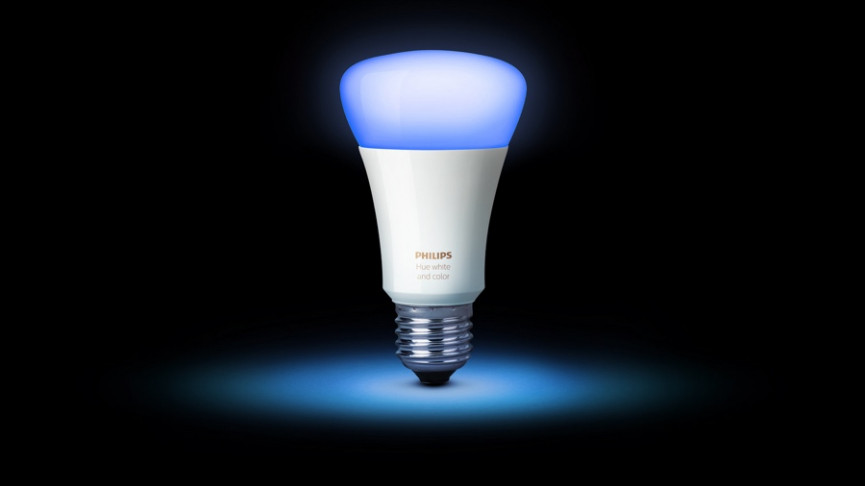
The first thing you need to decide is where you want your Philips Hue lightbulbs to go and then check the light fittings for those places. Hue bulbs are like regular lightbulbs – they will screw into pretty much any light fitting or lamp in your home.
The good news is that there’s a range of sizes and shapes for screwing your bulb in. In the US you can pick up A21, E26, E12, BR30 and PAR16 screw-in bulbs and GU10 bulbs for your spotlights.
In the UK, the names are slightly different but the options are pretty much on par. It’s E27 and E14 for your light sockets with screw sockets, GU10s for your spotlights and also the old-style B22 Bayonets as well, if that’s what you need.
The next thing you need to consider is bulb shape. There are regular round lightbulbs, candle shaped bulbs, flat bulbs for ceilings and also slick-looking curved ambience bulbs too. Most of these are available across the range of fittings mentioned above.
Hue’s also added smart filament bulbs to the mix, which have that exposed Edison-style vintage look to them, and are available in A19, ST19 and G25 sizings. They’re a great way to switch up the look of different rooms or lights if you’re going an in on Hue bulbs.
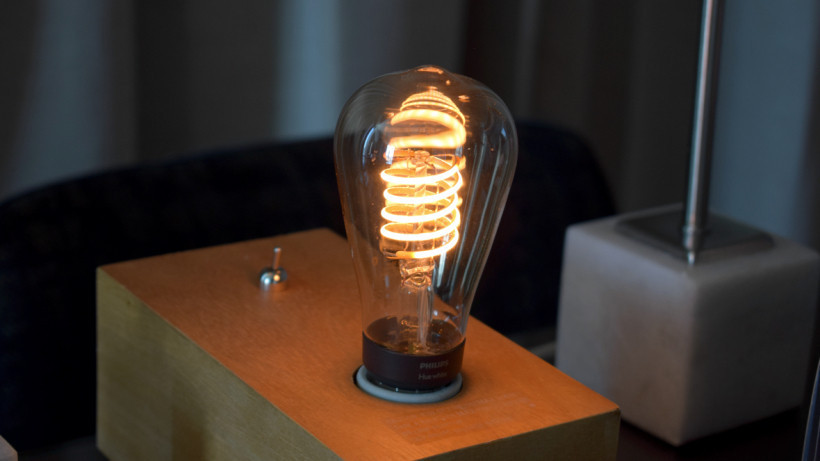
Finally, and the biggie – you need to decide on colors. With the “basic” Hue bulbs, there’s a choice between white, white ambience, and white and color ambience. The last one is the flagship of the range, offering a staggering 16 million colors and shades.
White ambience gives you more control over the shade and temperature of your white light (2200K-6500K) and plain old white doesn’t have different temperatures but is still dimmable like every other Hue bulb.
On the whole, they all shine around 800 lumens; although the brightest white bulb in Hue’s armory, an A21 bulb with 1600 lumens, went live in June 2020.
The Filament bulbs mentioned above shine at 550 lumens with a locked temperature color of 2100K, so they’re dimmer than the flagship range and only shine in one warm-orangey color.
With all Hue lightbulbs – all LED bulbs, obviously – you’ll get 25,000 hours of life from a 9.5-10W maximum output.
You can buy bulbs in single, double or different sized multipacks, depending on your location, with prices starting from $14.99 / £14.99 for a single white bulb to $49.99 / £49.99 for a solitary color ambience one.
Prices vary wildly though depending on what bulb fitting and shape you want exactly.
Philips Hue lamps and light fittings
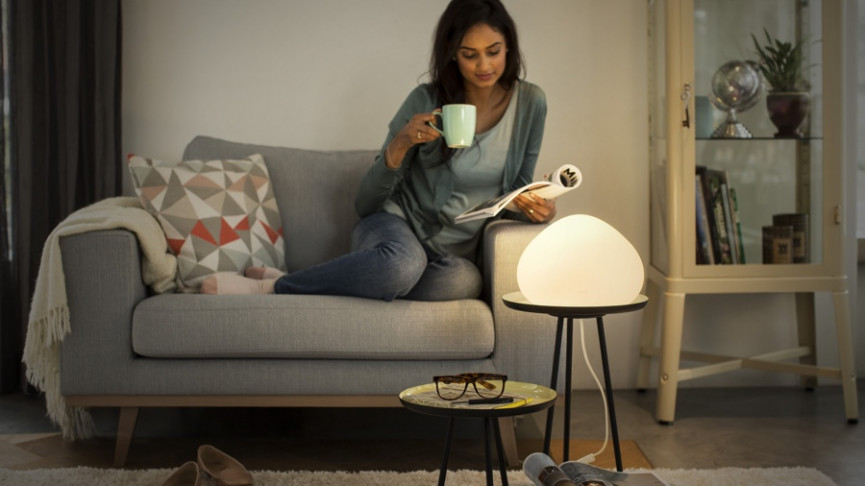
Rather than making your existing light fittings and lamps more connected, Hue also offers you the opportunity to go all out smart with lamps and light fittings designed to totally replace your 20th century lighting.
There’s around 40 different styles to choose from; the UK has a slightly larger selection than the Hue store Stateside.
There are wall lights, table lamps, spotlights, suspension lights, ceiling lights, runner lights, recessed lights, mirror lights – you name it, Signify has got it. Prices start at around the $40 / £35 mark and go well above $350 / £350 depending on your décor preferences.
Philips Hue Lightstrips

One of the coolest ways to light up your home with Philips Hue is using its colored Lightstrips. These thin strips can be hidden under kitchen counters, behind couches, around skirting boards – pretty much anywhere you want – and they add an array of futuristic looking lights around your home.
There’s even an outdoor version of the Lightstrip – perfect for Christmas or Halloween. They are water resistant and stick to your path via clips rather than sticky tape. Makes sense, as they have to be out in nature’s glory.
You plug one end into your mains socket and then 1m or 2m strips can be joined together to form a chain as long as 10m. Don’t worry if you can’t get an exact fit – they can also be cut to size.
The latest Lightstrip – the Bluetooth packing Lightstrip Plus – was announced in mid-2020 and includes the option to cut the Lightstrip to size and re-attach unused bits, or combine them with others using adapters. You can’t do this on the non-Plus models.
The Plus also allows you to add up to eight extensions, as well – so a maximum length of 16m, based on a device measuring 2m.
There are also specific lightstrips designed for the back of your TV, but we’ll get to that in a bit.
Philips Hue outdoor

Those light strips aren’t the only outdoor goodies, though. Philips Hue’s full outdoor smart lighting range launched in 2018 and there have been an absolute bonanza of new arrivals in the years that have passed since then.
The range consists of wall mounts, bulbs, spotlights and the already-mentioned Lightstrips. The Philips Hue Lily, which comes as a starter pack consisting of three spotlights and is designed to highlight design features in your garden and illuminate flower beds and plants.
There’s also the Philips Hue Calla (640 lumens, like the Lily), which is a path lighting option. The base pack includes one bollard, additional ones can be purchased seperately.
If you’re looking for wall mounted fixture lighting then you’ll be interested in the Philips Hue Inara (800 lumens), Lucca (800 lumens) or Ludere (2600 lumens). Philips also has a dedicated outdoor bulb – the white PAR38 which are $29.99 each or $49.99 for a two-pack and are rated at 1300 lumens.
Other new arrivals such as the Daylo, Nyro, Impress and Attract have boosted the amount of outdoor specific Hue lights to nearly 50 options.
You can, of course, use a regular Hue bulb in a waterproof outdoor fixing although Signify advises against it.
Philips Hue in the bathroom

Philips Hue Adore is its bathroom specific range of smart lighting. The star is the Adore White lighted mirror which has a ring of white LEDs and can be controlled by Alexa, Google Assistant, Apple HomeKit or a dimmer switch. It also has IP44 dust and water resistance.
Also in the range: the Adore Bathroom spot light, the Adore Bathroom mirror light and the Adore Bathroom ceiling light. They’re all white lighting, no colors, with chrome metal finishes and IP44 water resistance.
Philips Hue: The accessories
Right, so you’re all kitted up with the lights – now you just need a way of controlling them. The app is obviously your best bet (more on that next) but there are physical controllers too.
We’ve already mentioned the Hue Dimmer switch, but if you want something smarter then you’ll be looking at the $50 / £50 Hue Tap Dial. Working off kinetic energy – no batteries required – the Tap Dial lets you choose your four favorite scenes anywhere, at the touch of a button. You can stick it on a wall or use it as a remote control.
Alternatively, if you’re looking for a minimalist option, there’s Hue smart button that’s literally just a solitary push button. It can stick to fridges or metal magnetically, and long presses can be used for more control, but at $19.99 / £19.99 it’s an interesting option.
There are Hue Motion sensors which turns bulbs on based on movement. The indoor version costs $39.99 / £34.99, it’s $10 / £10 more for the outdoor model.
Both have a daylight sensor so you can choose to only have them operational when it’s dark. (Pro-tip… you could always use cheaper motion sensors and trigger your Hue bulbs using Alexa Routines and the like).
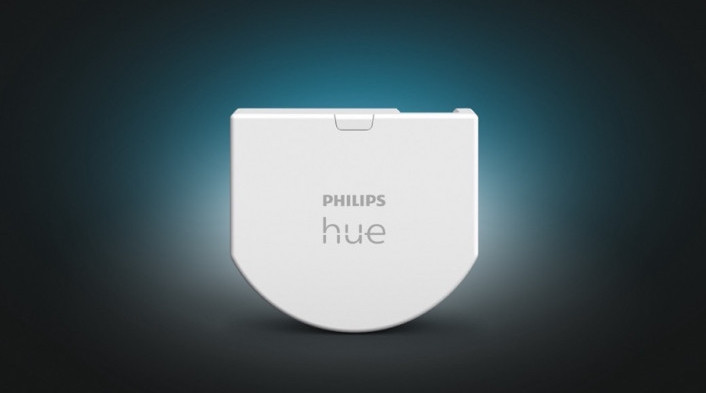
Signify debuted this long-awaited Wall Switch Module in 2021. With a Hue Wall Switch Module into your existing light switch, your smart bulbs are always usable, no matter the state of the switch.
The Philips Hue Wall Module is $39.95 for one or $69.95 for a two pack.
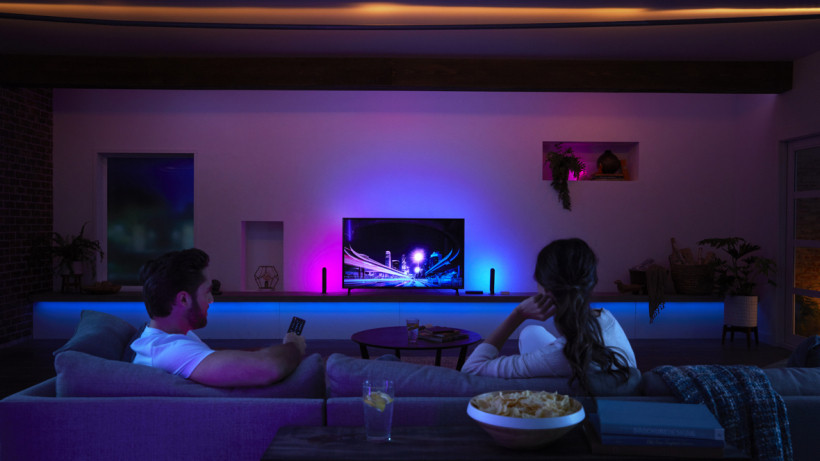
Philips Hue: For TV and gaming
In 2018 Signify launched the Philips Hue Sync App for Windows 10 PCs and Macs, which analyzes the content you’re playing (or watching) and syncs up your Hue lights so you can bathe your room in colors that match the action.
That was fine for some desktop gaming, but if you want it on your TV or living room console, you had to hook it up to your PC via HDMI, Chromecast or other means.
That problem went away with the Hue Play Sync Box, an HDMI pass-through that also functions as a Hue device, so you can plug in your various TV boxes and have all the on-screen action sync up with your lighting.
The box supports HDMI CEC and HDMI 2.0, so you can run 4K HDR content through it at 60Hz. You can connect up to four devices into the box via HDMI, and sync with up to ten color-changing Hue lights.
Pretty neat, and it’s easier than ever to set up with new Play-focused lights such the Gradient lightstrip.
The Philips Hue Play Gradient Light Tube fits into this entertainment side of the Hue line-up well. It’s a follow-up to the Gradient Lightstrip, and offers a solid tube of LED lights rather than a strip you’ll need to attach to a wall or other surface. Just place it above or below a TV, or wherever you like, and you’re done.
Philips Hue has also updated a couple of its lines with Gradient tech. This lets Hue lights display multiple colors at once, rather than cycling through flat tones.
The Hue Signe table and floor lamps are Gradient models, for $199.99 (table) and $299.99 (floor).
Back in 2023 at CES, Signify and Samsung announced a partnership that meant that people wouldn’t need to cough up for a HDMI Sync Box to get that ‘Ambilight’ effect, as the duo launched a new app that does the job without the need for additional hardware.
However, it wasn’t all good news as there was still the need to cough up $130 / £115 for the Philips Hue Sync TV app.
Fast forward a year or so and there’s now a more appealing entry to the light syncing TV action, with a $2.99 / £2.69 monthly subscription on offer.
What the app does is essentially replaces the external Hue Sync Box hardware and powers everything from inside your Samsung TV instead, effectively meaning your Samsung TV can act as a Play Sync Box, offering a unique light syncing experience with anything you watch or play on your TV.
Philips Hue: Syncing with smart assistants
As great at the Hue app is, it’s no longer as vital as it once was. And that’s because of Philips’ Friends of Hue program. Hue has always been open with the likes of IFTTT, Logitech and Xfinity but has added Google Assistant, Apple HomeKit and Amazon Alexa to the mix.
This means not only voice controls for turning your lights on and off, but extra security measures like having all of your lights turn on if motion is detected by a certain camera, for example.
Using voice assistants or IFTTT you can also create elaborate scenes across all of your connected tech such as having your temperature set to your perfect sleeping level, while at the same time having your lights turned off, your blinds closed and your security alarm armed.
The scenarios are seemingly endless and Hue is easily one of the most supported smart home platforms – you’ll struggle to find connected kit that doesn’t play nicely with it.
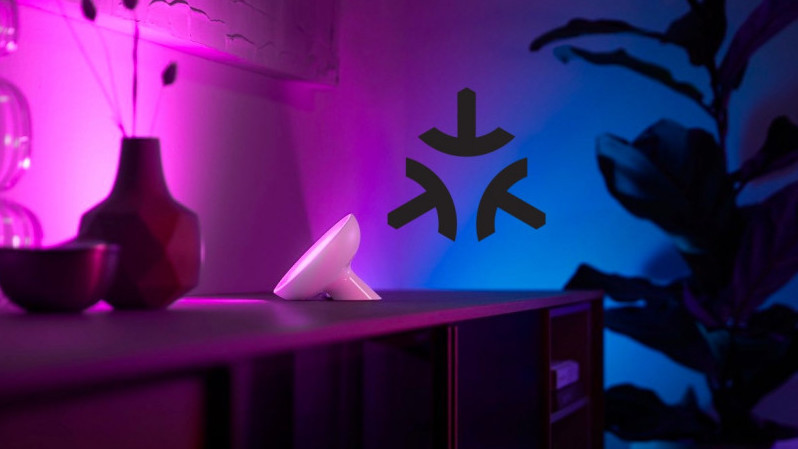
Hue and Matter
And there’s, in theory at least, extra smarts available to Hue users thanks to Signify embracing the Matter smart home standard… sort of.
You can pair your Hue Bridge to a Matter controller and get all the benefits of the emerging smart home platform.
Those benefits aren’t going to make much of a difference to Hue users just yet but, as Matter matures in the months and years ahead, Hue users will be able to take advantage of everything that comes with that.
At present, the only Hue device that is Matter certified is the Bridge – the bulbs and lights will only be able to play a part of a Matter smart home system when connected to the Bridge.
For now, you’re probably asking yourself why exactly you’d even bother using Matter, rather than say Echo Skill, to sync up your Hue bulbs to your smart home ecosystem of choice.
The main reason, for now at least, is it would take some of the heavy lifting off of the cloud-based integrations we currently all use, and bring things in house.
Philips Hue and Spotify
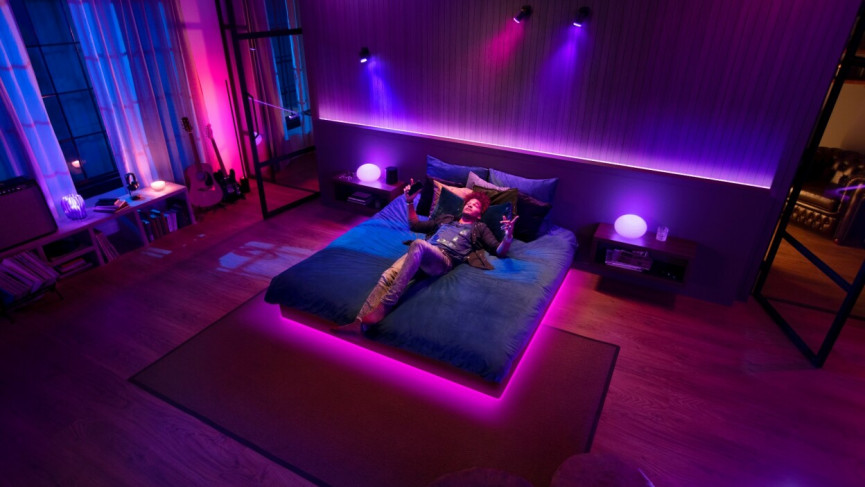
Back in 2021, Spotify partnered with Philips Hue to develop “deep integration of lighting and music”. Bulbs and light strips will pulse in time with the music, and use color shades that fit the track.
This is possible because the Hue app gets access to Spotify’s track metadata, which includes information on a song’s tempo, genre, mood and more. It’s the information Spotify uses to help categorise its millions of tracks into endless playlists.
Philips Hue Secure: smart security system and cameras

Officially unveiled at IFA 2023, Philips Hue now offers smart security cameras and sensors too.
The Hue Secure cameras come in both battery and wired options, and there’s also a Floodlight Hue Secure camera too.
A key selling point is that the new Hue security cam is end-to-end encryption by default. This means that no processing of footage is done in the cloud, it all happens locally on the devices themselves.
Everything is powered in the new Security Center, which can be found in the Philips Hue app. You’ll need both a Hue Bridge and a Hue account to get started.
From the app you’ll be able to do all the usual smart security stuff such as manually triggering an alarm that flashes your Hue lights, sounding the siren on your Secure camera, or even calling the police, or a friend or family member.
Because Philips Hue has been around for a while, and because the platform is so open, there’s a heck of a lot more you can do with your bulbs outside the official app and ecosystem.
As well as the official app you’ll find a tonne of third-party Hue apps across Google Play and the App Store – more than 700, in fact. Most are rubbish – that’s always the way with an open API – but there are a few gems that add features to the mix that the official app doesn’t allow for.
Top picks include Hue Disco for adding some color to your home party and OnSwitch for grouping your Hue bulbs with your Lifx ones in the same app. Check out our guide to the best Philips Hue apps for more.
Here’s something you won’t read on the Signify’s website (actually you will, but you’ll have to do some digging): you don’t actually need Philips Hue bulbs in order to have a Philips Hue system.
Philips Hue is part of the Zigbee Light Link standard protocol and, as such, Zigbee Light Link compliant products and devices work with the Hue Bridge.
It can be a bit fiddly, but you can get cheaper bulbs such as Ikea’s, GE’s and Osram’s all set up on your Hue system. To learn more, take a look at our guide explaining how to set up Ikea Trådfri on Philips Hue or getting your Innr bulbs working with Hue.
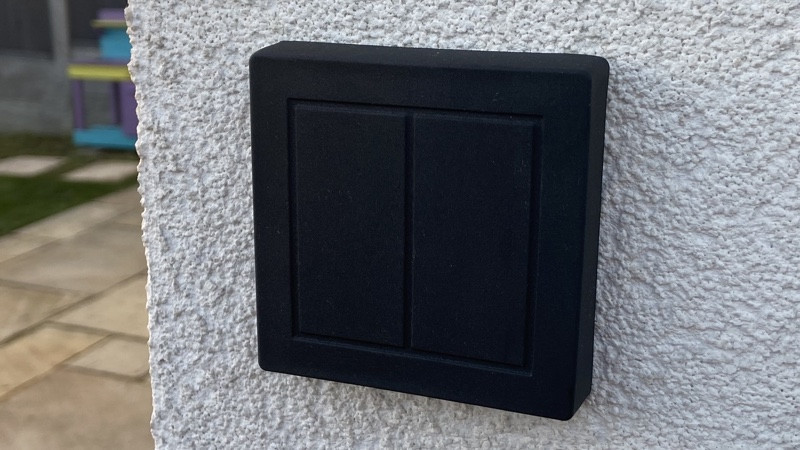
Friends of Hue
The Friends of Hue initiative, whereby you buy accessories – think switches and the like (like the Senic Outdoor Switch pictured above) – and, although they aren’t official Hue products, they act as if they are.
You add them through the Hue app and they connect to your Hue Bridge using Zigbee.
Check out our guide to the best Friends of Hue switches for your Philips Hue system.
Here are a few more how-tos to get you going…
How to reset Philips Hue bulbs and Bridge
If your bulbs or Bridge aren’t responding, you’ll need to do a hard reset. When it comes to bulbs, you can do this reset through the app, but if you’re not using the Hue Bridge or app, you’ll have to go via whichever hub you’re connected through. Head to our full explainer for more.
How to set up Philips Hue with Alexa
1. Make sure your Philips Hue light is turned on and ready to connect.
2. Download the Philips Hue Skill on your Alexa device.
3. Say “Alexa, find my devices” and wait for 45 seconds while the assistant scans the area for any new devices.
4. Once a bulb is discovered, you can connect it up through the Alexa app and control it manually or through your voice. Just make sure to name it something easy to say.
5. Whether you have a bridge or not, you can control your lights using just your voice. Try a command such as, “Alexa, turn bedroom light to 50%”.
Check our full guide to Philips Hue and Alexa.
How to sync your Hue lights with the weather
Whether it’s for setting the mood or you just fancy being a little more in touch with nature, one of the coolest Hue tricks you can do is have them replicate a certain type of weather or adjust to sync with the conditions outside. It’s not even that difficult to do – here’s how.
How to sync Philips Hue with movies and games
As we mentioned up above, another trick the Hue Sync app offers is being able to add extra immersion to movies and games by having your Hue bulbs adjust to what’s happening on-screen. Head to our full guide to learn how.
Add a Friends of Hue switch too the mix
Friends of Hue smart switches are effectively smart buttons that allow you to control your Hue lights. And it’s easy to set these up directly in the Hue app.
Senic’s Friends of Hue Outdoor Switch is one of our favorites in this area.
Philips Hue: The competition
Philips Hue might be the leading light in the smart lighting world, but there are plenty of smart lighting alternatives now on sale.
Lifx is the most obvious pretender to Hue’s crown – it’s a bridge-less system that offers and app that (dare we say it?) is slightly better and easier to use than Hue’s, with cheaper price points and an ever-growing army of bulbs and accessories. Watch this space for sure and check out our comprehensive Lifx guide.
Nanoleaf, which started out as a smart light panel specialist has emerged as a genuine Hue alternative in the past couple of years, as it expands into lightstrips, bulbs and spotlights too.
The Ikea Trådfri range turned up at the smart lighting party in early 2017 and, while there still aren’t many bells and whistles, smart assistants, colored bulbs and increased compatibility are breathing life into the platform – and as mentioned above, you can even get Ikea’s cheaper bulbs playing nicely within your Hue setup. Read our Ikea Trådfri review for more.
Other names vying for space in an ever-expanding smart lighting arena are Innr, Nanoleaf, Osram, Wemo, Hive, Wyze, Sengred, Govee and Elgato. Check out our smart lighting hub page to stay up to date with all the news, reviews and analysis.







